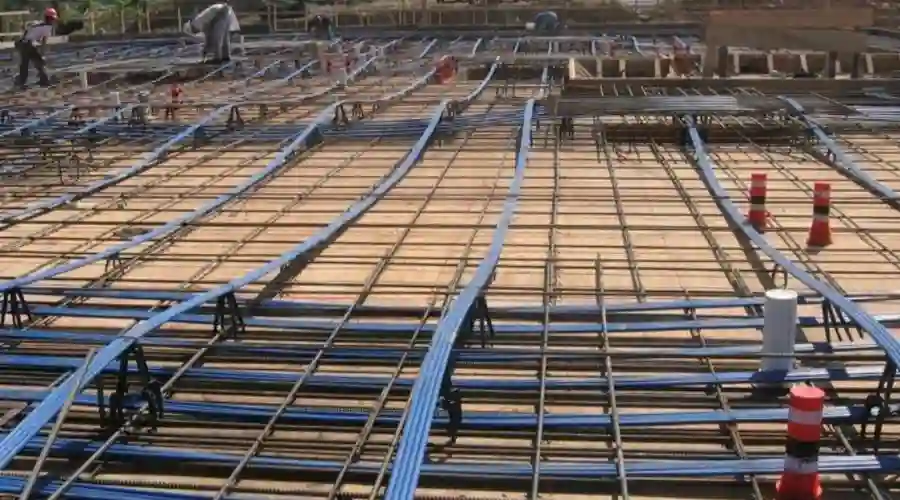In the field of construction, you may have heard these terms- PT slab and RCC slab. There is hardly any awareness about what differentiates them, as for the most part, people think they are the same. But let’s explore in detail how they differ with respect to what they are made of and what benefits one holds over the other. This will enable you to find which slab is the most suitable for your project.
What is a PT Slab?

A PT Slab or Post-Tensioned Slab is a type of concrete slab reinforced with high-strength steel cables (tendons), that are stretched and tensioned after the concrete is hardened. This tensioning process increases the overall strength, durability and load-bearing capacity of the slab. This helps in countering the external tensile stress and is ideal for structures where long spans or thin slabs are crucial.
What is an RCC Slab?
An RCC slab or Reinforcement Cement Concrete Slab is a traditional concrete slab that is reinforced with steel rebars or mesh embedded within the slab. These reinforcements are used to resist tensile stresses, while concrete resists compressive stresses. These slabs are easy to design and construct and are most commonly used in construction. The strength of the slab depends on the amount of reinforcement and is used for short-spanned, and thicker slabs.
Key Differences between PT Slab and RCC Slab
| Feature | PT Slab | RCC Slab |
| Construction Method | The steel tendons are tensioned after the concrete is hardened. | It uses steel reinforcement bars embedded within the concrete structure. |
| Strength | It offers higher strength due to the post-tensioning process. | The strength of the RCC slab varies based on the amount of reinforcements added to the structure. |
| Span | It is suitable for the construction of longer spans without supports or columns. | It is limited to shorter spans compared to the PT slabs. |
| Thickness | These slabs are comparatively thinner due to the post-tensioning process. | These slabs are generally thicker and are designed to counter tension and compression. |
| Flexibility | These slabs are suitable for structures with large spans. | These slabs are highly suitable for buildings with shorter spans. |
| Cost | It is expensive due to the need for specialized labour and materials. | It is comparatively less expensive, and traditionally used in construction. |
| Construction Time | The designing and construction of the PT slab is time-consuming, due to its complex designing and post-tensioning process | It is faster to construct, as it uses a conventional method, with readily available materials |
| Maintenance | It requires regular inspection and maintenance due to the stress caused by the steel tendons, due to tensile forces | These slabs are easier to inspect and maintain but may need more frequent repairs. |
Advantages and Disadvantages of PT Slab vs RCC Slab
PT Slab
Advantages
- It is ideal for structures where longer spans with no intermediate supports are crucial.
- It helps in reducing the development of cracks, especially when the slab is subjected to heavy loads.
- These slabs offer help in withstanding deflection, improving the stability of the structure.
- It helps in achieving flatter soffits, which are flexible in improving the overall looks of the building.
Disadvantages
- These slabs are more expensive due to the need for specialized equipment, experts, and skilled labourers.
- The construction of the PT slab is complex and time-consuming when compared to the RCC slab.
- The stress in the tendons can lead to corrosion over time, if not properly protected
- It requires regular inspection and maintenance, to check for potential corrosion or disconnection.
RCC Slab
Advantages
- RCC slabs are affordable, due to their simpler design and construction with readily available materials
- It does not require skilled labourers or specialized equipment for installation, which reduces the overall construction cost.
- These slabs are highly flexible and can be compatible with different architectural styles and designs, making them more flexible.
- It is a good insulator that protects the structure from extreme fire and hot weather conditions.
Disadvantages
- RCC slabs are comparatively thicker and more dense, which reduces the headroom.
- RCC slabs are prone to cracks or damage in places of heavy loads, leading to more frequent inspections and maintenance.
- These slabs are limited to shorter-span construction.
- It requires more columns or supports for longer spans.
When to Choose PT Slab?
PT slabs can be a greater fit for projects with large open spaces such as high-rise buildings, sports arenas and bridges, where intermediate columns or supports are not desirable.
It is a thinner slab with high durability, that reduces the cost spent on materials and maintenance. This makes it ideal for structures where increased floor height, without spending more money on materials and maintenance is crucial.
These slabs are ideal for withstanding heavy loads without causing deflection or cracking and, hence can be used for places where load-bearing is crucial.
When to Choose RCC Slab?
RCC slab is one of the most commonly used slab types in construction, however, it is a greater fit when working on a tight budget, and wants a cost-effective solution.
It is suitable for buildings with shorter spans, where standard reinforcements are adequate.
It can be used for construction that requires quicker construction due to a fixed timeline, as they can be constructed with readily available materials and labourers.
Conclusion
In summary, PT slabs and RCC slabs have established themselves as essential members of the modern construction family, with each serving its special values. RCC slabs are time-tested and any type of construction can rely on them. PT slabs are stronger and more flexible, used when the construction becomes complicated. Understanding the significant differences between them help you choose the right kind of slab for the respective construction purposes.

